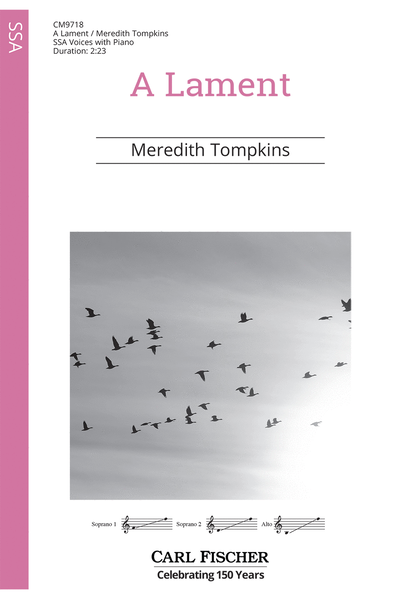Details
Description
SKU: CF.CM9718
Composed by Meredith Tompkins. 8 pages. Duration 2 minutes, 23 seconds. Carl Fischer Music #CM9718. Published by Carl Fischer Music (CF.CM9718).ISBN 9781491160978. UPC: 680160919574. Key: D major. English. Manmohan Ghose.
Manmohan Ghose was a professor, poet, and brilliant scholar from Eastern India in the late 19th century. He was educated in London, and was one of the first poets originally from India to publish poetry in English. "A Lament" is one of his earliest published poems; it progresses with vivid, scenic language from lullaby to permanent goodbye. Much later in life, Manmohan experienced a series of family tragedies that gave him a unique perspective on grief. After returning to India to mourn his father's death and eventually the passing of his wife, he never again made it back to England as he had wished to before his own death. The text of this piece has been paired with a mixolydian modal structure and a blend of musical elements designed to invoke a nostalgic, dream-like atmosphere. In the words of the composer: "I like to think of this piece as a metaphorical hall of mirrors. The original 'image' of the melody becomes the source for multiple echoes and imitations that blossom into layers of polyphonic movement." As a nod to the poet's birth place, notes reminiscent of the kan-swar grace note technique of Hindustani classical music add ornamental interest to the piano and voices. This piece functions as an excellent educational introduction or further study into the concept of modes. When presenting this piece to a choir, directors may find it helpful to identify G as the tonal center and follow up with an explanation that G mixolydian has the same key signature as the key of C, because it naturally has no sharps or flats.
Manmohan Ghose was a professor, poet, and brilliant scholar from Eastern India in the late 19th century. He was educated in London, and was one of the first poets originally from India to publish poetry in English. “A Lament” is one of his earliest published poems; it progresses with vivid, scenic language from lullaby to permanent goodbye. Much later in life, Manmohan experienced a series of family tragedies that gave him a unique perspective on grief. After returning to India to mourn his father’s death and eventually the passing of his wife, he never again made it back to England as he had wished to before his own death. The text of this piece has been paired with a mixolydian modal structure and a blend of musical elements designed to invoke a nostalgic, dream-like atmosphere. In the words of the composer: “I like to think of this piece as a metaphorical hall of mirrors. The original ‘image’ of the melody becomes the source for multiple echoes and imitations that blossom into layers of polyphonic movement.” As a nod to the poet’s birth place, notes reminiscent of the kan-swar grace note technique of Hindustani classical music add ornamental interest to the piano and voices. This piece functions as an excellent educational introduction or further study into the concept of modes. When presenting this piece to a choir, directors may find it helpful to identify G as the tonal center and follow up with an explanation that G mixolydian has the same key signature as the key of C, because it naturally has no sharps or flats.

 Share
Share